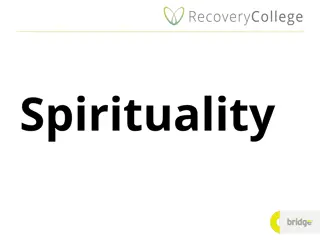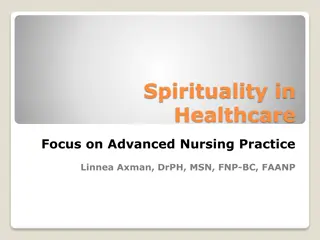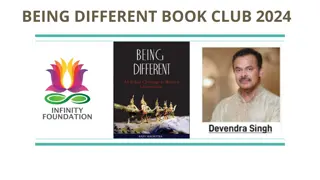Exploring Self-Sacrifice in Spirituality with Study Circle Agenda
Delve into the essence of self-sacrifice through a spiritual lens in a study circle setting. Explore the true meaning of self-sacrifice, learn to embody it in daily life, and discover how self-confidence and satisfaction connect to this virtue. Engage in activities, discussions, and meditations focusing on selflessness and spiritual growth.
Download Presentation

Please find below an Image/Link to download the presentation.
The content on the website is provided AS IS for your information and personal use only. It may not be sold, licensed, or shared on other websites without obtaining consent from the author. Download presentation by click this link. If you encounter any issues during the download, it is possible that the publisher has removed the file from their server.
E N D
Presentation Transcript
Leading a Spiritual Life Self-Sacrifice
Its a supplemental doc! Please read the newsletter before conducting the study circle with this document.
Agenda Purpose Materials Video Opening Meditation Digging Deeper Activity Scenarios Answers to Prema Vahini Chaps 16-23
Purpose of Study Circle 1) Delve into the true meaning of self-sacrifice 2) Learn to embed and practice self-sacrifice in our daily lives 3) Understand how self-confidence and self-satisfaction lead to self-sacrifice *Read Page 1 of the newsletter document now to understand the purpose of this study circle further and to find out how our Swami is an epitome of Self-Sacrifice!
Materials needed for the study circle 1. Copy of the newsletter document (to refer to during the study circle). 2. Papers, pens/pencils, some form of coloring utensils (for YAs to use for activities in the newsletter and study circle). 3. Ability to play a YouTube video and meditation audio recording (internet, computer, etc.).
Video Nature is a great example of self-sacrifice. Each particle of this universe gives up itself for a larger good. Watch this short video clip to admire the sacrifice deeply embedded in the creation of the cosmic one. http://www.youtube.com/watch?v=wIIBbPEo8NY
Video: Follow Up Quote ...Man is the zenith of creation But that speck of Chaithanya or Life- Consciousness won through. Sheer intelligence, adaptability and perseverance in 'willing' to live helped it to defeat the mortal fury of the elements. By the unfolding of that Chaithanya, the amoeba blossomed into various species of living beings, gigantic and microscopic; at last, it grew into man; in man, it bore fruit as goodness and virtue, sympathy and sacrifice, oratory and music, song and dance, scholarship and sadhana, martyrdom and sainthood, and as repositories of Divinity; nay, even divine Manifestations assumed the human form. - SSS vol 6
Opening meditation: Tree Meditation Introduction to Meditation: As this creation is occurring every moment on a cellular level, creation manifests itself on a macro level. Take the example of a tree, God gives it the soil, sun, and water, the same soil, sun and water it gives to all plants. The tree in turn gives oxygen to all beings. This is the tree s dharma. It does not feel special because it is able to give oxygen, it is just doing is dharma in life with its special gifts from God to help sustain life by emitting oxygen. Contemplate on the beauty and self-sacrifice of creation while performing the meditation in the following slide.
Listen to Recording Please play the audio file on www.saiyausa.net for Meditation recording. Adapted from the tree meditation listed in Phyllis Krystal s book - Cutting the ties that bind ; chapter 7, pg. 45-48.
Reviewing Self-Confidence and Self-Satisfaction Before we discuss self-sacrifice in this study circle, jump back to Page 2 of the newsletter now and do the activity on reviewing self-confidence and self-satisfaction!
Understanding the topic of Self-Sacrifice Before we dig deeper into this topic of self-sacrifice, refer to back to Page 3 of the newsletter now and read a conversation among 3 young adults as they try to understand self-sacrifice!
Digging Deeper: What is Self-Sacrifice? Read the following quote and answer the questions in the next slide: Compared to ordinary actions which are done by thinking of yourself as the doer, actions done without any sense of doership will be much greater. But, an action that is done with complete selflessness, performed impersonally with total indifference and without any attachment - is greater still. But when the action is entirely offered to the Lord, when it becomes a holy sacrifice, it is even more sacred than all of these. Thus, Krishna commanded Arjuna to offer all his acts to the Lord. When Arjuna reached this state of evolution, that is, when Arjuna acted completely selflessly and offered everything he did to the Lord, Krishna began to teach him the Gita. XXXII - Page 326, Sai Gita
Digging Deeper: What is Self-Sacrifice? Questions: 1) Consider various types of actions described in the quote: a) action without doership b) action with detachment and c) holy sacrifice. Is there a difference between these types of actions? Can you think of examples in all three categories? 2) After reading the newsletter and the study circle discussions, one might feel that they should be perpetually busy doing action or seva, sacrificing for others? How do we find a healthy balance between all our activities, the worldly life and Spiritual life ? Do these distinctions exist?
Digging Deeper: What then is the reward? Read the following quote and answer the questions in the next slide: ...It is because such supremely self-sacrificing, great men have existed in Bharat from times immemorial, that Bharat has shone as a Thyaga Bhoomi (the land of Sacrifice), Yoga Bhoomi (the land of Yoga) and Karma Bhoomi (the land of sacred deeds). Today sacrifice and charity have become a fashionable pastime. It has also been turned into a business. If a trivial donation is made, it must be blazoned in the press! In the old days, the great souls and rulers who gave away kingdoms and all their possessions, indulged in no fanfare, but experienced the bliss of giving in their hearts. Those great souls totally ignored those who came in the way of their acts of sacrifice. -Excerpt from the discourse at the Poornachandra Auditorium on 3-9-1990, the day of Onam festival.
Digging Deeper: What then is the reward? Questions: 1) Have you faced a situation at home, with family, in the Sai organization, or at work where you have wanted recognition for an act performed? Describe the experiences to each other in the group. 2) If part of self-sacrifice is not performing an act for the reward, what is the purpose or motivation for performing the act?
Digging Deeper: Different degrees of self-sacrifice Self- sacrifice is the highest form of renunciation where one adheres to all moral values and is in synchrony with the need of the hour without any thought to personal gain- emotional or material. As we progress on our spiritual path, self-sacrifice might take many forms. Swami clearly describes the various stages in the following excerpt taken from Sai Gita, XXXII - Page 326. ...In the primary stage, every human being has to perform actions and be actively employed in the tasks for which he is suited. One needs to perform action in order not to develop laziness. A lazy person is absolutely useless to the world. Swami does not approve or encourage anyone to be lazy. First, you must perform ordinary actions. Then you should enter into the stage where you perform all your actions without any self- interest. Gradually you transform these actions into yoga, you transform work into worship. This is one of the core teachings of the Gita.
Different Religions on Self-Sacrifice Have you ever wondered how the different religions view self-sacrifice? Jump to Page 4 of the newsletter now to read and find out!
Activity Read the following quote and refer to the next slide for the follow up activity. Bear in mind two things. You must forget the good you have done to others. Remembrance of such good deeds gives rise to expectations of return or a feeling of envy. The other thing which you should forget is the harm done by others to you. Brooding over the harm done by others will only give rise to feelings of hatred and retaliation. Forgetting then and there the harm done by others will free the mind from evil thoughts. Sathya Sai Baba
Activity 1) Take out a sheet of paper and write down situations in your life that the quote (on the previous slide) reminds you of. 2) Reflect on how you reacted to these situations and the outcomes thereof. 3) Consider any unique thoughts about how the experience could have been different based on practicing self-sacrifice. 4) Finally, display your thoughts by visualizing this quote and how it defines self-sacrifice to you in the form of a picture, cartoon, image, poem, or any other form of art. *Moderators, please collect this artwork and submit using link on www.saiyausa.net*
Case Scenarios on Self-Sacrifice In the following few slides, discuss each of the scenarios and brainstorm solutions based on what we have learned so far on self-sacrifice.
Scenario 1 You have been working hard to keep away from work politics as much as possible. Recently, your boss has heard various negative complaints about you from your work colleagues. You have been putting in a lot of work toward your projects and feel that they have gone unrecognized. You feel that based on these complaints, you might lose your job if your boss does not hear about the positive things you are doing. Is recognition sometimes important? Is the job important?
Scenario 2 You are home with your children all day, are responsible for all the housework and additionally have some projects of your own that you are working on. Your spouse is traveling for extended periods of time and when he/she arrives home, reports that he/she is too tired to help out to get the house ready for a large dinner to host a work colleague. Discuss if the spouse at home all day should continue sacrificing to prepare the house or if the working spouse should share a part of the workload. Explain the reasoning
Scenario 3 Your parents are getting older and you want to help them in any way possible. You are currently living across the country from them with your immediate family and are employed in your ideal job. In this situation would you sacrifice your job and move home to live closer to your parents or would you consider alternatives? Discuss sacrifice as it applies to this situation. If you act without any feeling of doership, doing your work as holy sacrifice, does it matter what you decide to do?
Scenario 4 You are a student and are very busy in school. A close friend of yours asks for help on an unrelated subject. Consider the following. Since you are good friends, you decide to help him and not study for your exam. While you are helping your friend, you notice another student in your class using that time to study for the same exam. How would you reconcile with this situation? Say this student you see studying actually gets better grades than you at the end of the semester. Would you regret doing the service? If so, is it still considered self- sacrifice? Do you feel that helping your friend and potentially losing time to study for yourself is a form of self-sacrifice?
Story Corner Each of us could face the scenarios described in the last few slides! It was thus beneficial for us to review these scenarios together. To get inspired further, refer to the story corner (Page 6) of the newsletter document now to read two heart-warming stories on self-sacrifice! Also, to read fellow YAs thoughts on self-sacrifice, refer to Page 1, 3, and 4 of the newsletter document.
Cultivating Self-Sacrifice Why and how should we cultivate self-sacrifice in our lives? Jump to Page 5 of newsletter document now to read and find out! Below are practical tips for each of us to take home and practice:
Independent Study: Prema Vahini Individual Reading of Prema Vahini , Chapters 16-23 Answers to questions on Page 7 on newsletter: 1) B - Samskaras 2) C - Death 3) D - All of the above 4) C - Destruction of the mind 5) D - Sanathana Dharma 6) B - Vedas and Sastras 7) A - One who is the Eternal Witness 8) D - Brahman 9) A - I and Mine feelings 10) C - Body, Jivi (Soul 11) A - Namasmarana 12) True 13) D - Yagnam 14) D - All of the above 15) B - Prema (Love)
Finish with Om Shanti Shanti Shantih.























